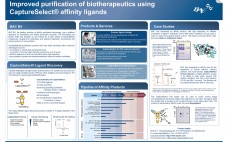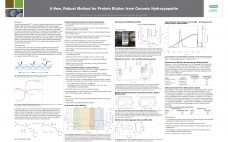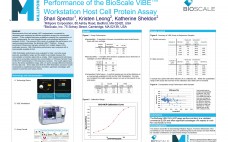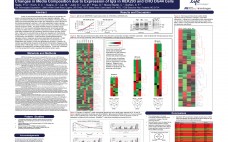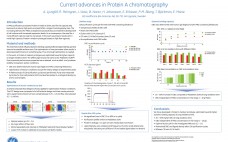BAC BV – The Affinity Experts – develops novel & cost-effective solutions for affinity purification challenges. Affinity chromatography is one of the simplest and most effective methods for purifying protein therapeutics, offering reduced process steps and higher yields than non-affinity methods can provide. For standard MAb purification Protein A is a well established affinity ligand which clearly has demonstrated the benefits of a highly selective primary capture step. However, for non antibody based therapeutics and novel antibody formats lacking a…
Sponsored Content
A New, Robust Method for Protein Elution from Ceramic Hydroxyapatite
Ceramic hydroxyapatite (CHT™) is used for protein purification owing to its superior removal of all process-stream impurities (aggregates, HCP, viruses, endotoxin, protein A, DNA, etc.). At commercial scale CHT performance can be impacted due to the release of protons during elution. This proton release lowers mobile phase pH which may impact the robustness of CHT particles. We have developed a novel, patent-pending technology called the surface neutralization system (SNS), which desorbs protons from the surface of CHT prior to elution.…
Cell Culture Design Space Modeling using a Scale-Down Approach
As an industry initiative to “provide assurance of quality,” the ICH Q8 guideline proposes building quality into the design of experiments by defining the process design space within which critical product quality attributes are within an acceptable range. A characterized design space not only enhances process knowledge but also can later be utilized for process validation and regulatory filings, saving on the time and cost of additional filings if process changes are implemented in the future. Because it is neither…
Performance of the BioScale ViBE Protein Analysis Workstation Host Cell Protein Assay
Measurement of host cell protein (HCP) contaminants is essential for developing and monitoring an effective purification process for recombinant proteins. Of the multiple techniques available to quantify the concentrations of these contaminants, the most popular format uses polyclonal antisera in a sandwich ELISA. The purpose of this work is to evaluate the performance of a newly emerging technology; the BioScale ViBE™ Platform. Using an assortment of bioprocess samples selected from multiple stages of the purification process, ViBE Workstation performance was…
Integrated clarification and product capture for high titer bioreactor harvests
Clarification and capture challenges are inherent in a new cell culture process that extends the exponential growth phase of mammalian cell cultures, resulting in high cell densities and product titers. Here, we show that second generation Expanded Bed Adsorption (EBA) technology is ideal for processing such high titer, high cell density harvests. In these culture harvests, viable cell densities of > 100 million cells/mL and product titers > 10 g/L are observed routinely, using standard media and cell lines. Several…
Application of animal-free recombinant bioactive protein supplements to improve the performance of cell-based viral vaccine production
The development and regulatory approval of continuous cell lines for manufacturing viral vaccines has brought numerous benefits to production processes. We and others have contributed to upstream advances by improving cell culture media with the development of animal-free and chemically-defined recombinant protein supplements. The supplements developed include recombinant insulin-like growth factor-I (LONG®R3IGF-I), epidermal growth factor (LONG®EGF), transforming growth factor-α (LONG®TGF-α), transferrin (CellPrime™ rTransferrin AF), and albumin (CellPrime ™rAlbumin AF-G or -S). Extensive literature on the action of these bioactive proteins…
Changes in Media Composition due to Expression of IgG in HEK293 and CHO DG44 Cells
Quality of recombinant/therapeutic proteins produced by engineered cell lines is a concern shared by both manufacturers and regulatory agencies. New assays are needed to facilitate earlier and more rapid analysis of therapeutic protein quality. Cell culture supernatant contains secreted proteins that are indicative of the cellular condition and thus are potential indicators of recombinant protein quality. This study identified changes in secreted host cell proteins (HCP) from cell pools exhibiting varying levels of recombinant antibody expression as determined by quantitative…
Fc-Specific Mix-Mode Ligand for Monoclonal Antibody Purification
APT1604 is a base-stable 600 Da peptidometic ligand coupled to a 6% cross-linked agarose matrix. APT1604 binds to Fc-fragment of monoclonal antibodies (mAb) and various immunoglobulin (IgG) subclasses. The interaction between protein and ligand has been suggested to result from mixed mode ionic – hydrophobic interactions, albeit with high selectivity for immunoglobulins. The main application area for APT1604 is purification of mAb from mammalian cell harvest, but it can also be used for purification of IgG from other sources. The…
Factory of the Future
Fed-batch and perfusion culture are two dominant modes of operation for mammalian-cell-culture based processes. Challenges in the industry (such as competitive products for the same indication or desired cost reductions) are forcing many to explore new production options. Increasingly popular is the application of the ATF™ System to generate ultra high viable cell concentrations (>100m cells/ml) for a “concentrated” or “intensified” process. The use of the ATF System in a typical concentrated fed-batch process is shown which has generated a…
Current advances in Protein A chromatography
In this work we present results with a novel high capacity Protein A medium prototype based on high flow agarose. The medium prototype was optimized for higher dynamic binding capacity (DBC) at long residence time. A 20–50% higher DBC was obtained compared to MabSelect SuRe™. DBC was independent of MAb concentration in the range 1–10 g/L. Optimization of elution conditions (pH and flow rate) was performed by design of experiments. A lifetime study for 100 purification cycles, performed with a…

